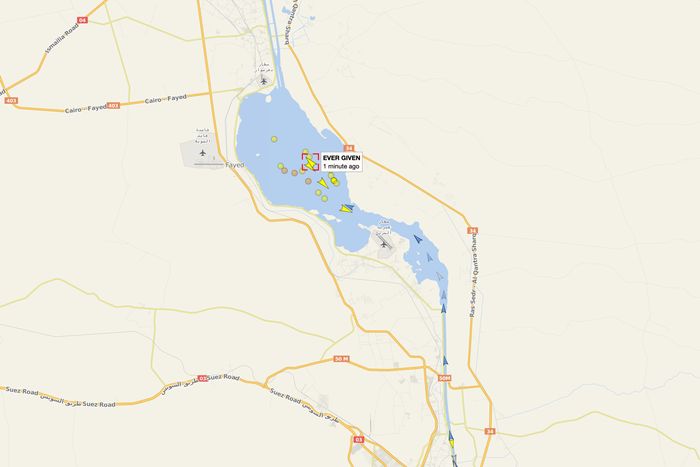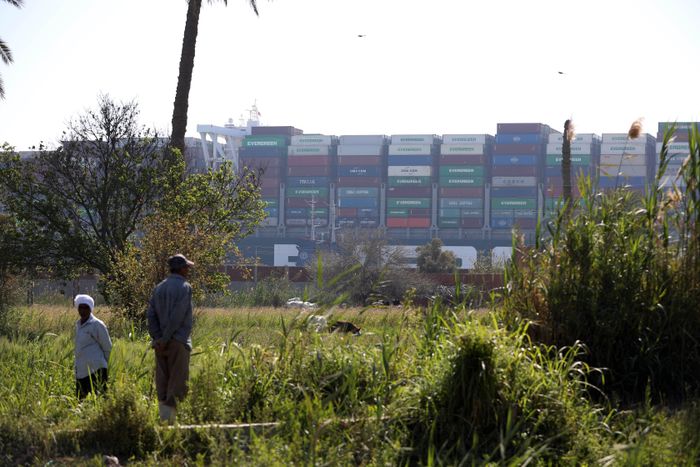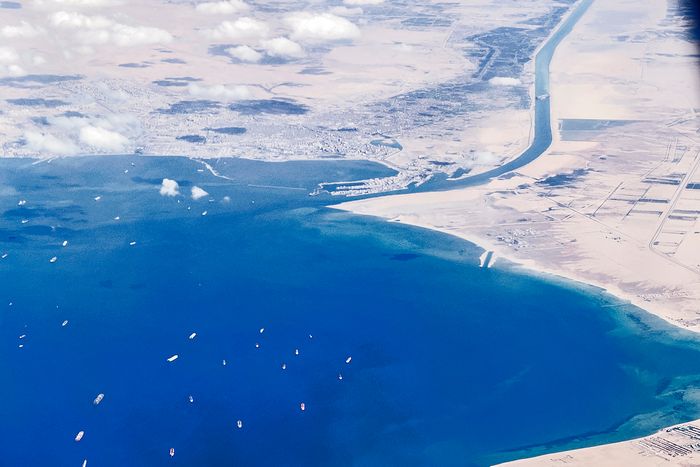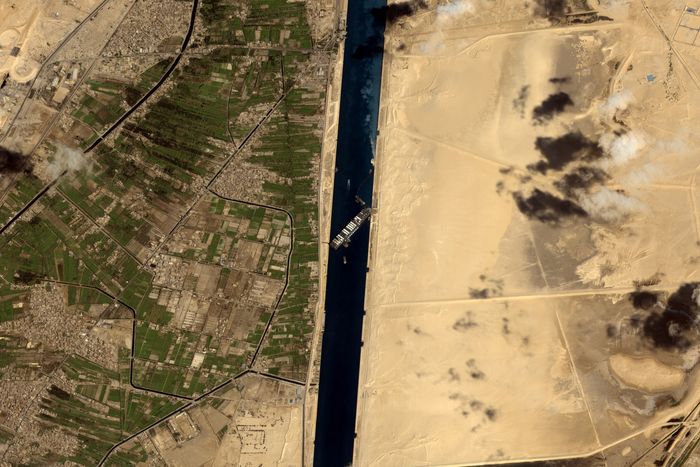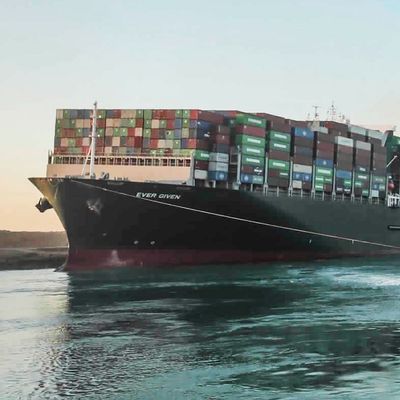
The saga of the world’s most famous stuck ship, the Ever Given, is finally over. Ongoing attempts to dislodge the massive, Empire State Building–length container vessel — which blocked off the Suez Canal in Egypt when it ran aground diagonally last Tuesday — at last proved successful on Monday. Below, the latest updates on an overdue triumph and its aftermath.
Bring on the backlog
With the Suez Canal open again, the ships are starting their runs through — and going a little faster than normal, reports the Wall Street Journal:
By 3:30 a.m. local time Tuesday, 306 ships waited to go through from both ends of the Suez Canal, down from 356 the previous day, according to Leth Agencies, a shipping services provider.
To help clear the backlog caused by the 1,312-foot-long ship named Ever Given, the Suez Canal Authority is expected to increase the number of vessels moving through the waterway each day. Although the canal’s average daily traffic totals 40 to 50 ships, the maximum authorized number is 106 vessels a day. On Aug. 2, 2019, 81 ships went through the canal, breaking a record …
According to the Suez Canal Authority, the maximum speed allowed through the canal is between 7.6 and 8.6 knots, but ship-tracking website Marine Traffic shows most of the ships are traveling around 8 and 10 knots at the moment.
Crisis averted — which means it’s officially time to start worrying about the next crises which could involve big ships
This time it was a big ship stuck in the Suez, but what about the globe’s other vulnerable waterways? At Time, retired U.S. Navy admiral and current Carlyle Group executive James Stavridis highlights additional at-risk routes:
There is another fundamental lesson to be relearned here, and it about more than just the Suez Canal. It is the criticality of a handful of so-called “choke points” around the world upon which the global navigational grid depends. These are spots where traffic patterns collide, and the tens of thousands of ships underway on the world’s oceans at any given moment come together in tightly managed traffic schemes. I spent a significant chunk of my life at sea passing through them. …
In addition to the Suez Canal, there are three international straits and one other canal that represent the major maritime choke points. These are the Strait of Malacca that separates the Pacific and Indian Oceans; the Bosporus Strait that separates the Aegean and Black Sea; the Strait of Bab-El-Mandeb at the tip of the Arabian Peninsula; and the Strait of Hormuz at the mouth of the Arabian Gulf. The other canal, of course, is the Panama Canal.
The Panama Canal was widened in 2016, at a cost of more than $5 billion, because, the New York Times noted Tuesday, the ships have gotten too damn big:
[T]he argument for even bigger ships may finally be fading, even for container lines themselves — a concept known in economics as the law of diminishing returns. For one, the benefits of building bigger tend to shrink with each successive round of growth, according to Olaf Merk, the lead author of a 2015 International Transport Forum report on very big ships. According to the report, the savings from moving to ships that can carry 19,000 containers were four to six times smaller than those realized by the previous expansion of ship size. And most of the savings came from more efficient ship engines than the size of the ship …
The bigger vessels can also call on fewer ports and navigate through fewer tight waterways. They are also harder to fill, cost more to insure and pose a greater threat to supply chains when things go wrong, like Ever Given’s beaching in the Suez Canal. Giant ships are also designed for a world in which trade is growing rapidly, which is far from guaranteed these days given high geopolitical and economic tensions between the United States and China, Britain and the European Union, and other large trading partners.
Climate change may also lead to a whole host of problems for global shipping, as Dr. Jeff Masters explains at Yale Climate Connections:
While the connections to climate change of the grounding of the Ever Given and closure of the Suez Canal are speculative, the event serves as a warning that climate change can be expected to cause an increase in extreme events that will impact critical global trade chokepoints. As explained in a 2017 report from Chatham House, much of the food required to feed 2.8 billion people passes through 14 critical shipping chokepoints[:] maritime corridors such as straits and canals, coastal infrastructure in major crop-exporting regions, and inland transport infrastructure in major crop-exporting regions. These chokepoints are at risk of closure due to three factors:
1) Extreme weather events or sea level rise;
2) Security and conflict hazards from war, political instability, piracy, organized crime and/or terrorism; and
3) Decisions by authorities to close a chokepoint or restrict the passage of food (for example, by imposing export controls).
Thirteen of the 14 critical chokepoints have had a closure or interruption in transit at least once between 2002-2017, with the Strait of Gibraltar the only exception.
Beware cyberattacks, too, cautions the Center for Security Policy’s Virginia Coates and the Hudson Institute’s Robert Greenway in a Bloomberg op-ed:
For now, the greatest Suez vulnerability is in the cyber domain. We have witnessed numerous hostile cyber attacks against industrial control systems in recent years. The canal’s information technology and communications architecture — the equivalent of an air traffic control system — is equally vulnerable. Here the U.S. and Israel in particular can contribute new technology to ensure the system is properly safeguarded and possesses the necessary redundancy to protect it from malfunction or sabotage. Such steps would safeguard not only the vital maritime trade during the global recovery from the pandemic, but also ensure the protection of the equally-vital undersea communications cables which are co-located with the Suez Canal.
At Defense One, RAND’s Scott Savitz warns of “blockships” — a military strategy for deliberately getting a ship stuck in a critical choke point:
[This tactic] has a long history. British forces used it in both world wars, as did Union forces during the American Civil War. Earlier uses have been documented going back 1,000 years. But this ancient naval maneuver remains highly relevant in the twenty-first century: In 2014, Russian forces used it to trap most of the Ukrainian Navy in a Crimean port. By sinking two obsolete ships to obstruct the harbor exit, they prevented Ukrainian ships from escaping to sea, enabling their capture from the landward side.
In many ports around the globe, ships transit confined waterways that are no wider than the length of a large container ship. An attacker could bribe a crew to deliberately sink one, run it aground, or crash it at a narrow point in the approaches to a port. Alternatively, electronic or cyberattacks against a ship’s control system could cause a channel-blocking accident. Clearing a blockship can take days or weeks, enough time for the other side to make military gains that are difficult to reverse. The trapped ships and submarines are also vulnerable to missile attack, having become a set of fixed targets.
But while security analysts highlight fears of ongoing threats and future disruptions, there’s at least one subset of people whose fear will end as global attention shifts away from the gargantuan Ever Given, Soo Youn reports for the Guardian:
“If we’re just looking at pictures or talking about it, I get goosebumps all over my body,” she explains. The massive ship, which had blocked the canal since Tuesday and was finally set free on Monday morning has devastated global supply chains, threatened oil rations, and — as a comically large object lodged indefinitely — launched a thousand memes.
But for some, it’s caused a different problem — it’s triggered their fear of big ships. The response touches a few different phobias: megalophobia (the fear of large objects) submechanophobia (a fear of submerged — partially or entirely — humanmade objects) and naviphobia or navisphobia (a fear of ships and sea wreckage) …
Intersecting all of these phobias, the Ever Given crisis provides the perfect storm to activate these anxieties, psychiatrists say.
Great Bitter Lake achievement unlocked — Canal to reopen
The Ever Given has reached Great Bitter Lake on the Suez Canal, where its hull will be inspected for damage — and where it can stay the hell out of the way so other shipping traffic can resume. The Suez Canal Authority has announced that navigation through the channel will start up again at 8 p.m. local time Monday.
By early Tuesday morning, the 113 ships stuck in the canal were expected to exit in both directions, according to Reuters. The Suez Canal Authority chairman Osama Rabie also claimed that the backlog of over 400 ships waiting to get through the canal could be cleared in as little as three-and-a-half days.
The Ever Given is free
An international fleet of tugboats working to dislodge the 220,000-ton Ever Given from the banks of the Suez Canal finally helped free it on Monday around 3pm local time, allowing global trade to resume, but depriving the internet of prime meme material.
Around 5:45 a.m., the tugboats — aided by the high tide granted by a full moon — had successfully been able to get the Ever Given refloating in some capacity, after almost a week in the ground. But it had seemed there was still a long way to go, because while the massive ship’s stern has been pulled away from the shore, its bow, which presented a far greater challenge, was still stuck in the sand. Yet just hours later, the Ever Given was floating down the canal.
The New York Times provided a glimpse of the logistical complications the rescue mission entailed:
The company that oversees the ship’s operations and crew, Bernhard Schulte Shipmanagement, said 11 tugboats had helped, with two joining the struggle on Sunday. Several dredgers, including a specialized suction dredger that can extract 2,000 cubic meters of material per hour, dug around the vessel’s bow, the company said.
With the Ever Given sagging in the middle, its bow and stern both caught in positions for which they were not designed, the hull had been vulnerable to stress and cracks, according to experts. Just as every high tide brought hope the ship could be released, each low tide put new stresses on the vessel.
One Egyptian tug boat team was ebullient after the job was done.
Before the ship was even fully freed, Egyptian President Abdel Fatah al-Sissi sounded a note of triumphalism, saying “Egyptians have succeeded today in ending the crisis of the stranded ship in the Suez Canal.”
But the disruption isn’t over
Per the Wall Street Journal, though movement is back underway, the effects of the Ever Given’s blockage — which affected as much as 15 percent of the global container shipping capacity, holding up as much as $10 billion worth of goods a day — are expected to linger:
[The shortage of shipping containers needed to move goods around the world]—which emerged last year and has persisted recently—is likely to get worse even though the ship that was blocking the canal, the Ever Given, was freed on Monday. Thousands of shipping containers have been stranded in ships idling at the canal, and many more are on ships that were rerouted around the southern tip of Africa, a trip that takes about two weeks longer.
All those containers won’t be arriving in ports when originally expected, with potential domino effects for the world’s importers, exporters and manufacturers. …
Meanwhile, ports that are already strained from Covid-related issues might become more congested as the canal reopens. That is because a sudden traffic flow through the Suez could send a flood of ships that are behind schedule to skip docking in smaller ports and head to bigger ones to try to make up for lost time.
And the accounting has just begun. According to the Washington Post, the investigation into the incident will focus on potential human and technical errors, in addition to weather; it is widely believed that strong winds during a dust storm helped cause the Ever Given to get stuck. A natural event also helped get the ship out: The Wall Street Journal details how higher tides during a super moon helped unlodge the massive vessel.
The things the ships carry
According to Agence France-Presse, experts estimate that between $3 and 9.6 billion worth of goods are now stuck or delayed in transit because of the Ever Green’s mishap. That includes livestock on at least 20 ships, the Guardian reported Friday:
Georgios Hatzimanolis, a spokesperson for the tracking website Marine Traffic, said while some livestock ships were waiting to enter the canal, three – the Omega Star, the Unimar and the Sea Star – “all appear to be stuck at various points in the canal”. Marine Traffic data showed 11 delayed livestock ships, while an NGO has identified others, bringing the total identified so far to 20.
Five of the ships identified had loaded animals in Spain, and nine had loaded in Romania earlier this month, according to the NGO Animals International. … There were no immediate welfare concerns for the animals, but if the Ever Given has to be lightened to make it easier to dislodge, using cranes to remove enough containers could take weeks and the surrounding ships would need to leave and find longer alternative routes.
That’s what Gerit Weidinger, the EU coordinator for Animals International, told the Guardian she is worried about:
My greatest fear is that animals run out of food and water and they get stuck on the ships because they cannot be unloaded somewhere else for paperwork reasons. … Getting stuck on board means there is a risk [for the animals] of starvation, dehydration, injuries, waste buildup so they can’t lie down, and nor can the crew get rid of dead animal bodies in the [Suez] canal. It’s basically a ticking biohazard timebomb for animals and the crew and any person involved.
The Sunday Times reports that Egyptian authorities arranged an emergency food drop for tens of thousands of livestock aboard stranded ships in the Canal.
Per the AFP and other sources, other stranded goods include:
- At least 100 vessels transporting oil, refined oil products, or liquefied natural gas
- At least 17 chemical tankers, according to Bloomberg
- 80 containers of tea (across 15 vessels), according to the Rotterdam-based Van Rees Group
- 110 containers filled with Ikea goods
- At least one water tanker
- A consignment of French oak, bound for China for reprocessing into veneered flooring, after which it will be shipped back to the U.K.
As much as 90 percent of the affected cargo is not insured against delays, according to Lloyd’s List.
Will the rising tide lift this boat?
That’s the ongoing hope, the Associated Press explained on Sunday:
Workers planned to make two attempts Sunday to free the vessel coinciding with high tides helped by a full moon Sunday night, a top pilot with the canal authority said. The full moon offers a spring tide, or king tide, in which high tides are higher and the low tides are lower because of the effects of gravity during a straight-line alignment of the Earth, the moon and the sun.
Two more tugboats arrived on the scene Sunday. The peak high tide will occur a little before midnight local time tonight.
Ever Given’s sudden neighbors
The Washington Post’s Sudarsan Raghava reports from the village next to the Ever Given:
As the giant eyesore hovers above their houses and fields, some residents of Manshiyet Rugola and neighboring villages are angry at the disruption to their lives. Others worry the continued blockage of the canal will harm their nation and bring more economic distress. Most are just stunned that strong winds and a dust storm, the type of weather to which they are accustomed, could ground a ship and throw the world, including their small corner, into turmoil. …
Manshiyet Rugola, which means “small village of manhood” in Arabic, is a small community of farmers, drivers, laborers and blacksmiths, roughly four miles from the canal’s southern entrance, near the city of Suez. Unpaved paths lead inside the village, past red-brick houses, some half-built. On the dust-covered main road, peppered with military checkpoints, three-wheeled motorcycle taxis cart goods past stores and coffee shops.
The Egyptian government has been adding tension to local life, as well. The Post and other publications have noted that government security agents have been telling residents not to go near the stranded ship, take pictures of it, or speak with foreigners. “You can’t even go to the roof of a house to look at it,” one local told the Post.
There was also some astonishment from local residents about the idea that a windstorm could have been responsible for pushing the ship off course, with some noting that worse storms have struck and not affected ships traveling the Canal.
As the New York Times reports, some residents quipped that they’d like to see some of the ship’s cargo find its way to them:
“Why don’t they pull out one of those containers?” joked Umm Gaafar, 65. “There could be something good in there. Maybe it could feed the town.” …
“The whole village was out there watching,” said Youssef Ghareeb, 19, a factory worker. “We’ve gotten so used to having her around, because we’ve been living on our rooftops just watching the ship for four days.”
It was universally agreed that the view was even better at night, when the ship glowed with light: a skyscraper right out of a big-city skyline, lying on its side.
“When it lights up at night, it’s like the Titanic,” said Nadia, who, like her neighbor Umm Gaafar, declined to give her full name because of the security forces in the area. “All it’s missing is the necklace from the movie.”
As Bloomberg’s Supply Lines pointed out Sunday, residents would have a hard time getting close to the ship even if they weren’t worried about running afoul of Egyptian security agents:
A fence erected in 2014 has blocked villagers from the canal’s edge, otherwise they say they might have befriended their temporary neighbors. Years ago when ships ran aground, villagers remember crew-members tossing sodas ashore to children.
This time, locals are mostly far more concerned about what the blockage is costing their country, notes the Post:
The Suez Canal Authority and the government have invested some of the canal’s revenue, a major source of Egypt’s foreign currency reserves, in hospitals and schools in the area, residents said. The longer the crisis, the greater chance there will be less money for roads and other infrastructure, worries Ahmed, the coffee shop owner. “For six days now, not a single dollar has entered Egypt’s coffers from the canal.”
Kamil, who transports fish in his boats, said some of his friends’ livelihoods have already been impacted by the logjam. “They supply food and laundry services to the ships, but right now no ships are coming or going,” he said. …
Most residents can’t wait to see the Ever Given disappear. It has become a constant reminder of the possible economic calamity for their country, already reeling from lost income due to the coronavirus pandemic and dwindling tourists.
Egypt readies weight-loss scheme
Egyptian president Abdel Fattah el-Sisi has reportedly ordered the Suez Canal Authority to come up with a plan for removing some of the more than 18,000 containers off the Ever Given should efforts to re-float the ship — like Sunday’s high-tide maneuvers — continue to fail. That would serve to lighten the load, beyond other efforts to do so like emptying the ships ballasts and fuel tank — possibly making the ship easier to dislodge. Removing the cargo would not be easy, however.
Since there are no cranes nearby tall enough to reach the top of the container stacks, authorities would most likely need to use big helicopters to take the containers off, one by one. That wouldn’t work for all of the containers, either, just the ones light enough to be safely carried away by whatever helicopters can be made available for the effort. The Wall Street Journal suggests tandem rotor Chinook CH-47s could be used, but as Aerotime Hub noted last week, though the CH-47 is a world-renowned heavy-lift workhorse, it can only handle loads of less than 10,886 kilograms, which likely wouldn’t cut it for much of the Ever Given’s cargo:
While the exact number of cargo the Ever Given carries is not published, its capacity is over 20,000 20-foot-long (6.1 m) intermodal containers, although in its current configuration — as photos of the vessel show — the ship is mostly loaded with double-size, 40-foot-long (12,2 m) containers.
One empty 40-foot-long container weighs 2,400 kilograms (5,290 pounds) and can fit a maximum of 28,8. kilograms (61,910 pounds) of cargo, for a total maximum gross weight of whopping 30,480 kilograms (67,200 pounds). While there is a high chance not all of the Ever Given’s containers are filled to the brim, logistics companies typically try to maximize the load of their containers, as shipping empty space is not exactly efficient. Also, from the photos it appears the ship sits very close to its waterline, meaning that it carries almost as much as it possibly can.
The heaviest load any currently operating helicopter in the world can lift is 20,000 kilograms (with a Russian Mil Mi-26). The most any U.S. military helicopter can lift is 16,329 kilograms (with a Sikorsky CH-53K King Stallion).
The other option, Aerotime Hub explains, would be using mobile crane barges, but it’s not clear when those could be made available, or how safe they would be to deploy in this specific situation.
Offloading the Ever Given’s cargo by any means could also destabilize the ship — or even break it in half. As BBC News points out, experts say that should the weight not be removed from the ship evenly, it could create a catastrophic imbalance.
Not the Ever Given’s first accident
The Wall Street Journal notes that the 1,300-foot Ever Given hit a moored 75-foot pleasure ferry in Germany in 2019 — though a subsequent criminal probe did not uncover any wrongdoing:
The investigation found no misconduct and determined the captain of the container ship had been caught by surprise by winds. Its slow speed had limited his ability to maneuver the ship away from the river’s banks, the probe found. It couldn’t be learned if the current captain of the ship is the same as the one who was investigated in Germany.
As is standard procedure for any ships traversing the Suez Canal, local Egyptian crew took over steering the Ever Given through the canal last week.
Desperately seeking detours
As of Sunday morning, more than 360 ships were stuck at either end of the Suez Canal waiting for the situation to be resolved so that they could travel through. Meanwhile, the shipping giant Maersk has already redirected 15 ships around the Cape of Good Hope at the southern tip of Africa to avoid the blockage, and it has warned its customers that it could take as many as six days to clear its backlog of 32 vessels and counting at the canal (including three anchored inside). The world’s No. 2 shipping giant, Mediterranean Shipping Co., has redirected 11 ships around the Cape, and Hapag-Lloyd AG has redirected six of its vessels.
As The Wall Street Journal reported Sunday, the shipping industry is scrambling to adjust:
Shipping executives said even if the vessel is removed imminently, a backlog of ships waiting to pass through the canal would linger for days, and diversions of cargo could wreak havoc on port traffic around the world for weeks, upsetting the usually carefully orchestrated management of the world’s containers. The canal connects the Mediterranean and Red Seas and accounts for as much as 13% of seaborne trade and about 10% of maritime shipments of oil. …
Rerouting away from the Suez Canal intensified over the weekend as more shippers lost hopes of a quick resolution. Initial diversions around the waterway involved container ships and tankers that were still far away—typically sailing in the Atlantic on their way to Gibraltar to enter the Mediterranean. But now, container ships that are nearing the Red Sea also are abruptly changing course to go south around Africa.
That will delay their arrivals in Europe by up to two weeks and incur extra costs of as much as half a million dollars each. The diversions also threaten major port congestion in big ports in Europe and Asia, as all those diverted ships arrive late.
The good news about the Cape of Good Hope, at least, is that is no longer the treacherous shipwreck-prone path it once was when it earned the moniker the “Graveyard of Ships.” But the alternate route will take more time — a week or two extra — and cost a lot more in fuel. There is also the increased risk of piracy along that route, particularly off the coast of West Africa.
27,000 cubic meters of sand — and shifting
As of Sunday, Egyptian authorities report that they have already shifted 27,000 cubic meters of sand, to a depth of 18 meters, in an effort to dislodge the ship via dredging. A team of U.S. Navy dredging experts was expected to join the effort over the weekend.
100 feet of progress on Saturday
After successfully digging out the Ever Given’s rudder on Friday, tugboats working to free the Ever Given were successful in moving the ship two degrees (about 100 feet) by late Saturday, though the New York Times reports the bow remains “firmly planted in the soil and that the operation still faced significant hurdles.” Nonetheless, moving the behemoth at all was cause for celebration:
Syria begins oil rationing
The Syrian Arab News Agency reported Saturday that with no sure end in sight for the blockage of the canal, Syria’s government has begun rationing its oil supply “to ensure their vital availability for the longest possible time.”
This post has been updated to include new reporting and analysis.



